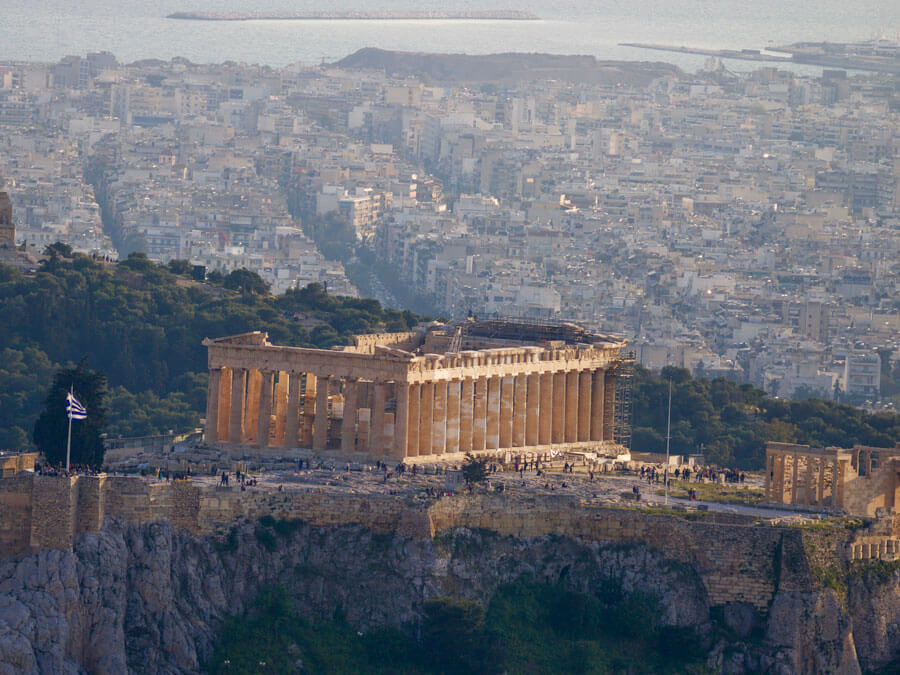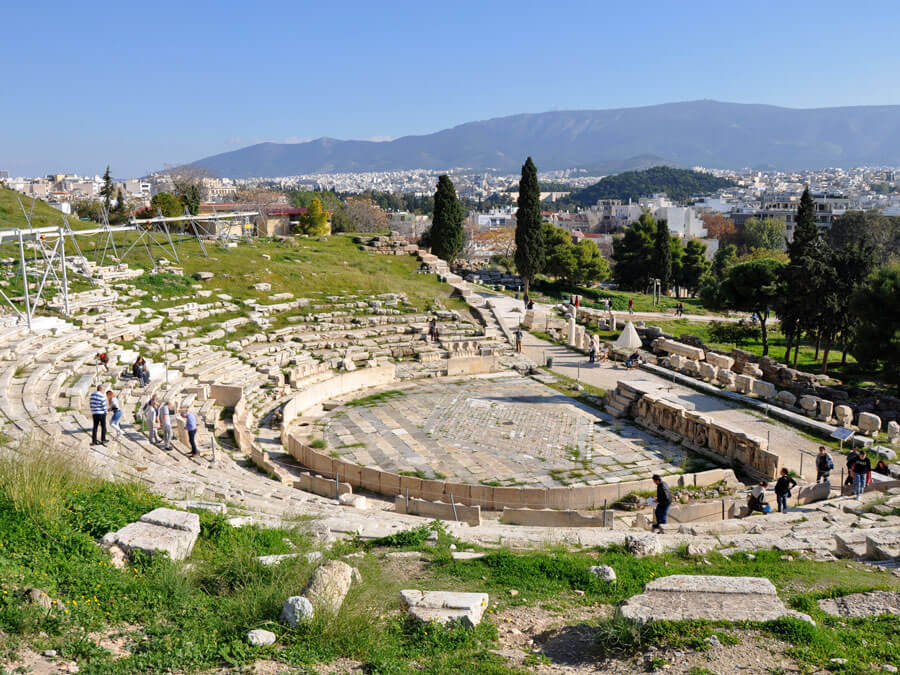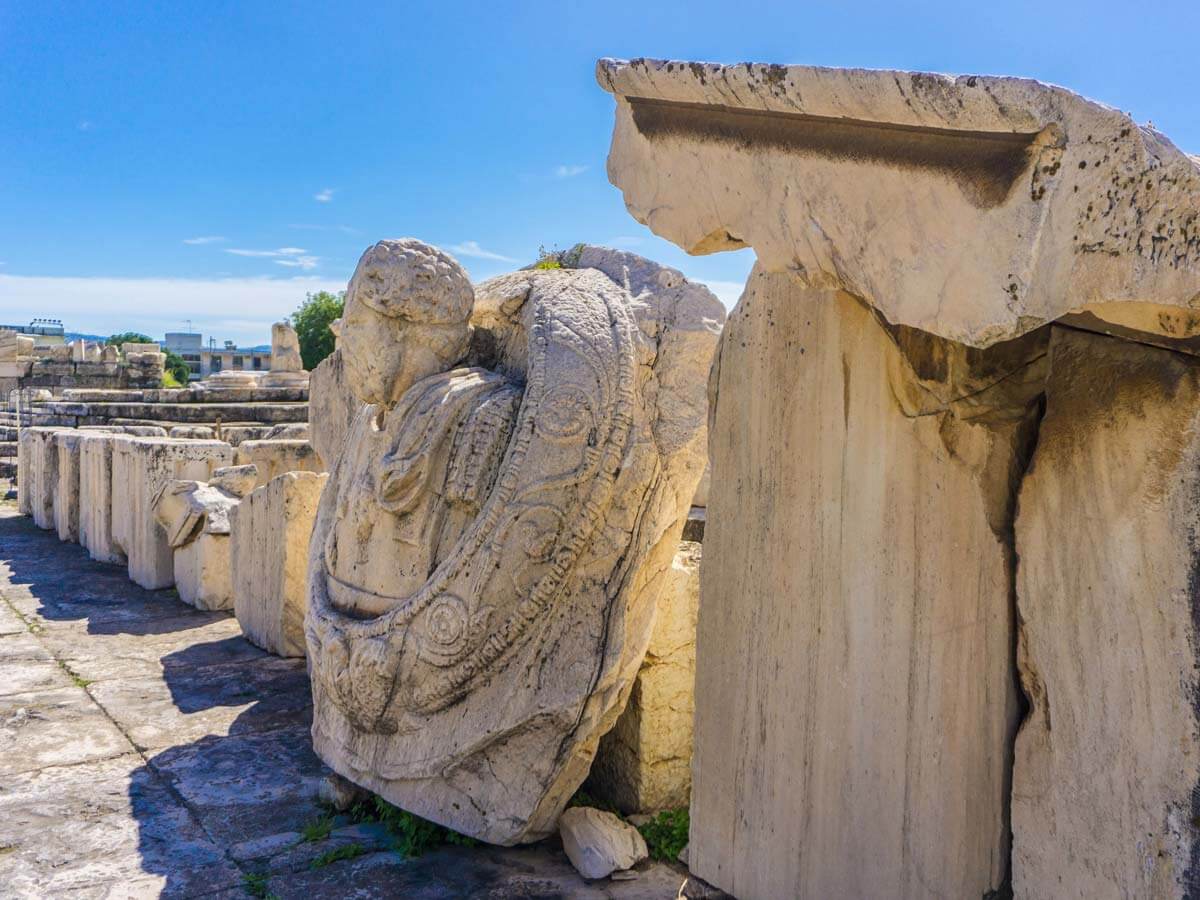1. The Battle of Athena and Poseidon for the Patronage of Athens
Relevant sites: Acropolis Hill, Erechtheion
Today’s capital of Greece is named after Athena, the goddess of wisdom. But it is interesting to know how Athena got that honor. According to Greek mythology, the city of Athens (which was then named Cecropia, after Cecrops, the supposed first Athenian king), had no patron god and Cecrops sought to establish a patron deity for his city. Two gods immediately declared an interest and sought to become patrons of Cecropia. One was goddess Athena, daughter of Zeus, and the other was god Poseidon, brother of Zeus. In order to settle their difference, it was decided that they would both present a gift to the people of Cecropia and the people would then vote the one they preferred (it was the land that later gave birth to Democracy after all). The stage for the vote was set and it was the Acropolis Hill, the highest point in the city. The citizens climbed the rock to watch the two gods present their gifts to them. Poseidon came first; he stood proudly with his trident in hand and gave a powerful blow to the ground. Shortly after, water started gushing from the rock and the people of Cecropia watched with wonder. Then, it was Athena’s turn; with her divine authority, the goddess thrust her spear to the rocky hill and a fruitful olive tree appeared. The securing of a constant source of water was vital for the city, however, they soon realized that Poseidon’s water was seawater (salted) and thus, it was not drinkable. Instead, Athena’s tree could provide them with oxygen, food, olive oil, wood and shadow. The people voted and it was Athena that won the contest thus, becoming the patroness of Cecropia. To appease angry Poseidon and prevent him from flooding the city, the people of Athens built the temple of Erechtheion on top of the spring of water the god had created. It is said that you can still hear the sound of waves coming from the inside of the temple when the wind blows from the south. Poseidon’s rage was soothed and Athena got the honor of naming the city after her. This is how Athens was named and you can still see an olive tree next to Erechtheion if you visit the Acropolis Hill, that it is said to be Athena’s olive tree.
Tip! You can enjoy a mythology tour of Acropolis with an expert licensed guide and delve deeper into the meanings and the importance of mythology for the Ancient Greek people.

2. Erichthonius: the Autochthonous Child
Relevant sites: Lycabettus Hill, Erechtheion and Temple of Hephaestus
According to Greek mythology, Hephaestus, the god of fire and blacksmiths, had a thing for the virgin goddess, Athena. When the goddess of wisdom went to his workshop to ask Hephaestus for a new weapon, the god of fire felt a strong impulse to make Athena his. The goddess managed to ward him off but soon realized that it was not before Hephaestus’ semen fell on her thigh. Disgusted, the goddess took a tuft of wool, wiped her leg and threw it on the Earth. Gaia, the Titan goddess and the personification of Earth, was fertilized and gave birth to a boy named Erichthonius (from “erin”=wool and “chthon”=earth). The infant was half-human and half-serpent. As soon as the child was born, Athena decided to raise him, but secretly from the other gods. Two drops of Gorgon's blood dripped into his eyes. One drop was to bring death to his enemies and the other to protect him from disease. He then placed the baby inside a box and gave the box to the daughters of Cecrops to guard it while she was away to carry rocks for the building of her Temple on the Acropolis Hill. She gave the sisters a clear instruction to not open the box and look inside. However, the sisters were very curious and opened the box which contained the infant. Seeing what was inside the box, they went insane and fell off the Acropolis Hill. A crow saw what happened and flew away to tell Athena. Filled with rage, Athena dropped the huge rock she was carrying and right in the spot where it fell, the Hill of Lycabettus was created. Erichthonius grew to become a legendary ruler of Athens and founded the Panathenaic Festival in honor of Athena. His tomb is said to be inside the Erechtheion on Acropolis.
You may also like:

3. The Trial of Ares and the Ancient Criminal Court of Athens
Relevant site: Areopagus Hill
There are many myths surrounding the name of this hill but the most famous is the one with the trial of Ares, the god of war. Ares, as expected, had numerous war crimes in his biography and nothing could stop him from adding more and more in the list. When he killed Halirrhothius, one of Poseidon’s son, for allegedly raping Alcippe, one of the daughters of Ares, the Olympian gods thought that it was time to take action; they decided that the god of war should be taken into trial! The other Olympians would be the judges and they decided to hold the trial on the top of the rock which is located between the Acropolis Hill and Pnyx. This rock later became the seat of the Athenian Criminal Court. It consisted of lifelong members of the aristocracy. All this, of course, until the democratic reforms of 462 BC, when the control of the nobles fell into the hands of the Municipal Church (“Ecclesia”). Orestes was trialed there, who fled to the Criminal Court to stand trial for the murder of his wife. He was acquitted thanks to the vote of the goddess Athena, which was used in favor of the defendant when the vote was a tie. When visiting Athens, you will find a rock right before you enter Acropolis, with many people on it taking photos and admiring the panoramic views of Athens. When you climb its top and gaze the wonderful view, do not forget: you stand on the ground of the criminal court of Ancient Athens, the same ground where the 12 Olympians stood and established justice into the mortal world!
![Credit: Berthold Werner <a target='_blank' href='https://creativecommons.org/licenses/by-sa/3.0'>[CC BY-SA 3.0]</a> Areopagus Hill across Acropolis](/images/Blog/Myths%20to%20know%20about%20Athens/Myths-in-Athens-the-trial-of-Ares-on-Areopagus-hill.jpg)
You may also like: The Hills of Athens and the Myths Connected to them
4. Τhe Birth of Dionysus
Relevant site: Theater of Dionysus
Dionysus was the god of wine and feast! It all started with Zeus's great love for Aphrodite's granddaughter, Semele. And as was often the case, Hera, Zeus’ wife, sought revenge against her! Taking the form of her nanny, she persuaded her to ask Zeus to appear before her in his divine form, to certify his identity. Semele, trusting her “nanny”, pressed the issue and Zeus appeared as a god, with all his glory, savagery and thunder; a thunder that killed her as she was bearing Dionysus, on her sixth month. Zeus took Dionysus stillborn from her belly, he stitched it to his thigh and carried him until he was born. When it was time to give birth, Zeus pulled him out of his thigh (the "Caesarean section" in mythology), and that is why they say that Dionysus was born twice! The interesting part of this particular myth is how it was integrated into the new reality after Christianity became the new religion. Today, you will find Greeks celebrating the birth of Christ during Christmas, the same day that they used to celebrate the birth of Dionysus. God Dionysus was called "Savior" and divine "infant", born of virgin Semele. In the winter, they mourned the killing of Dionysus by the Titans, but on the 25th of December, they celebrated his rebirth. The priestesses ascended to the top of the sacred mountain and holding a newborn infant shouted "Dionysus is reborn. Dionysus lives”. Today, Greeks still celebrate Dionysus with the festivities of Apokries (the Greek Carnival), a custom descending from the Feasts of Dionysus, and if you find yourselves in Athens during February don’t be surprised to see Athenians with masks dancing in frenzy at the alleys of Plaka! When visiting Athens and the Acropolis, make sure to not miss the theater of Dionysus which is the oldest theater in the world.

5. The Abduction of Persephone by Hades and the Establishment of the Eleusinian Mysteries
Relevant site: Archaeological site of Eleusis
The Eleusinian Mysteries were the most sacred religious rites of Ancient Greece, with many prominent men of antiquity being initiated into them. The cult of goddess Demeter and her daughter, Persephone, lasted for more than 1500 years. Although thousands of people were part of it, no one ever indulged the secrets of the rites and what was really taking place at the peak of the religious festival. One explanation for that absolute secrecy was the fact that the Athenian state had passed a law that made speaking of the mysteries an offense punishable by death! It all started with the god of the Underworld, Hades. When he saw the daughter of Demeter, Persephone, he was mesmerized by her beauty and wanted to make her his wife and Queen of the Underworld. One sunny day, the young goddess was picking flowers when suddenly the Earth yawned open and Hades appeared with his chariot and took her below, to his kingdom. Demeter was looking for her daughter day and night in vain. The land and crops of the earth began to wither along with the goddess of agriculture. After finally finding out the fate of her daughter, Demeter went to Zeus and demanded that she be returned, otherwise, she would not let the earth blossom again. Zeus had no choice but to ask his brother, Hades, to return Persephone to her mother and the world of the living. Hades obeyed but not before he gave to Persephone to eat a pomegranate. Persephone ate six seeds from it. It was well known that anyone eating food in the Underworld would be trapped forever there. However, Zeus and Demeter reached a compromise. Persephone would stay in the Underworld a month for each pomegranate seed she had eaten and then she would return again to the world of the living. This myth symbolized the circle of life and changing of seasons, with the return of Persephone to her mother being the coming of the Spring. The site of Eleusis where the Eleusinian Mysteries were taking place is still visible today and you can take a half-day trip from Athens to learn more about the secretive religion of the ancient world and the cult of Demeter and Daughter.
6. The Return of Theseus and the Death of a King
Relevant site: Temple of Poseidon in Cape Sounion
When visiting Athens, a trip to Cape Sounion and the Temple of Poseidon is a must for most travelers. The kingdom of the god of the seas, Poseidon, was the scene for another mythical event. Theseus was a legendary hero and the most beloved one for Athenians, like Heracles was for the Greeks. His father was King Aegeus, ruler of Athens. When Theseus was departing for the island of Crete, to kill the Minotaur in the Labyrinth and give an end to the yearly deaths, his father asked him for a favor. He asked him to change the sails of his ship from black to white on his return home so that he knew that he survived. The king was waiting anxiously on the top of a cliff in Sounion to gaze upon his son’s fleet. Theseus was successful in his adventure and managed to kill the Minotaur. However, with all the happenings and adventurous that he had on his return, he forgot his father’s appeal and returned with the same black sails. Seeing his son’s fleet covered in black, the great king’s heart filled with pain and Aegeus fell from the cliff into the sea below. From that day on, the sea is known as Aegean, after him. His son, Theseus, became the new king of Athens. Today you can visit the Temple of Poseidon from Athens and stand where Aegeus stood, waiting in patience for the return of his son.

Do you wish to explore the mythological sites of Athens with a true mythology expert? Have a look at:




